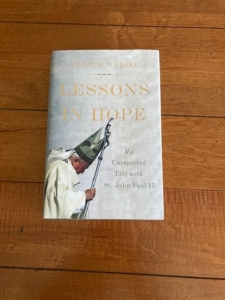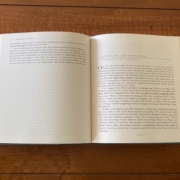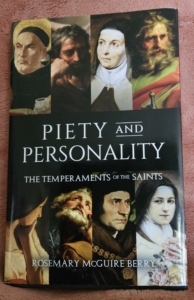Commentary and Book Review George Weigel, Lessons in Hope: My Unexpected Life with St. John Paul II
New York: Basic Books, 2017
Polish athlete, actor, and youth resistance leader Karol Jozef Wojtyla looms as a charismatic presence over the 20th Century, and beyond, with a personal and spiritual influence few before him ever accomplished. His life story exhibits the numinous arc of a genuine archetypal hero. Whether admirer or critic, almost no one on our planet could deny the depth or breadth of his impact on the world.
Elected supreme pontiff of the Roman Catholic Church in 1978, at the young age of 58, he was regarded by the College of Cardinals as an “outsider,” a “compromise” candidate. He was the first non-Italian pope in 455 years and the third longest servant of that office in history (1).
He took the Church to the world with his own two feet, visiting an unprecedented number of new countries that had never before even dreamed they might experience a pope’s physical presence and blessing in their own midst.
John Paul II was the second pope to visit the United States and he covered new territory even here on his first visit in 1979.
We all have our stories. Mine include intense negotiations in my Rand McNally office to determine who could take the day off to attend the papal mass in Chicago’s Grant Park on October 5, 1979.
When our family moved to Iowa in 1985, the very air still vibrated with the energy of 350,000 people who attended the papal mass at Living History Farms just outside of Des Moines on the Feast of St. Francis, October 4, 1979. At the time, it was the largest crowd ever present for a single event in Iowa history (2).
The atmosphere still shimmers today as the stories are told — about one farmer in a tiny Iowa hamlet, who believed he could just write to the pope with an invitation and the Holy Father would come.
Cherished memories of that glorious day continue to pass from one person to another, especially at this season of year when we celebrate the harvest with the Iowa State Fair.
People recall a stormy morning, full of thunder, lightning, and drenching rain – until the clouds broke, and the sun reappeared just as John Paul II’s helicopter came into view for a landing on the fertile fields. They remember his reverent words of appreciation for people who toil on the soil in stewardship, to feed us all.
I remember a French rail strike, an Italian train robbery, a powerful homily presented in four languages in 1995 by a man who still possessed the physical stamina to stand in St. Peter’s Square with a hot Roman sun beating down on his heavy vestments; a man who spoke long enough – more than an hour without respite — to make sure every person there heard his words from his own voice in a language they could understand.
My memories include a bittersweet final United States mass in St. Louis, Missouri just four years later, in 1999, when a pope by then crippled with Parkinson’s disease modeled humility, standing by and offering up his painful suffering while readers and translators presented the homily he had written — for the same reason, so everyone present could hear, and understand.
Many biographies of John Paul II have been published. So why do I want to tell you about this particular book, Lessons in Hope?
 George Weigel is a Distinguished Fellow of the Ethics and Public Policy Center in Washington, D. C., where he holds the William E. Simon Chair in Catholic Studies (3). He’s a prolific author of many books on a wide variety of Catholic topics (including several more recently published), and a regular contributor of thoughtful, incisive articles to the literary journal First Things.
George Weigel is a Distinguished Fellow of the Ethics and Public Policy Center in Washington, D. C., where he holds the William E. Simon Chair in Catholic Studies (3). He’s a prolific author of many books on a wide variety of Catholic topics (including several more recently published), and a regular contributor of thoughtful, incisive articles to the literary journal First Things.
Lessons in Hope is a unique hybrid. It’s a biography of John Paul II as well as an autobiography of George Weigel; it’s a memoir of a relationship that begins in Maryland in 1960, and concludes in Poland in 2012.
Organized chronologically and geographically, Lessons in Hope is a collection of vivid, digestible vignettes about how Divine Providence interwove the lives of two men who chose to spend their talents serving God and the Catholic Faith, each in their own different ways.
For more than 62 years, from Baltimore to Krakow — in Rome, Vienna, Moscow, Cuba, Portugal, Australia, Canada, Germany, and more – shuttling in and out of the weft, warp threads keep weaving together in their profound encounters.
What emerges is a tapestry that illustrates how the truths of our faith resonate most powerfully through our surprising interconnections with one another.
At this moment in 2025 when hope may seem for many of us quite difficult to maintain, Weigel’s book about his “unexpected life with St. John Paul II” offers timeless nourishment for each of our own life journeys.
May Christ’s peace that passes all understanding be with us now, and forever. Amen.
© Copyright 2025 by Margaret King Zacharias
Notes
- https://en.wikipedia.org/wiki/Pope_John_Paul_II
- https://www.lhf.org/aboutus-2/saint-pope-john-paul-ii-visit/#:~:text=On%20October%204%2C%201979%20Saint,cold%20and%20rainy%20autumn%20day.
- Book cover copy, George Weigel, Lessons in Hope: My Unexpected Life with St. John Paul II, New York: Basic Books, 2017.
Feature Image:
Author photo, used with permission
Inset photo: Cover of Lessons in Hope: My Unexpected life with St. John Paul II. Author photo, used with permission

 Margaret King Zacharias
Margaret King Zacharias
 Image by
Image by 

 She opens with brief paragraphs that generally describe each of the four. Then she jumps right into the saints and why she thinks a specific saint owns that particular temperament. This method of organization speaks to the point of the title, but at times, particularly in the chapters on St. Francis de Sales and St. Peter, while enjoyable, can be confusing and repetitive. In both, she moves on to address other saints of the same temperament, perhaps to give additional examples of the trait, but sometimes it sounds as though she is trying to force the saint to fit the trait. St. Francis de Sales is described as “Melancholic-Choleric” in the chapter title and she spends the first few pages talking about the Choleric disposition. She notes, however, that, upon studying his life and words, Choleric is the least of his traits. To her point, she impresses upon the reader that, ideally, we want to become a balance of the best of all four traits, which St. Francis de Sales achieved through a great deal of prayer, intention, and work.
She opens with brief paragraphs that generally describe each of the four. Then she jumps right into the saints and why she thinks a specific saint owns that particular temperament. This method of organization speaks to the point of the title, but at times, particularly in the chapters on St. Francis de Sales and St. Peter, while enjoyable, can be confusing and repetitive. In both, she moves on to address other saints of the same temperament, perhaps to give additional examples of the trait, but sometimes it sounds as though she is trying to force the saint to fit the trait. St. Francis de Sales is described as “Melancholic-Choleric” in the chapter title and she spends the first few pages talking about the Choleric disposition. She notes, however, that, upon studying his life and words, Choleric is the least of his traits. To her point, she impresses upon the reader that, ideally, we want to become a balance of the best of all four traits, which St. Francis de Sales achieved through a great deal of prayer, intention, and work.











